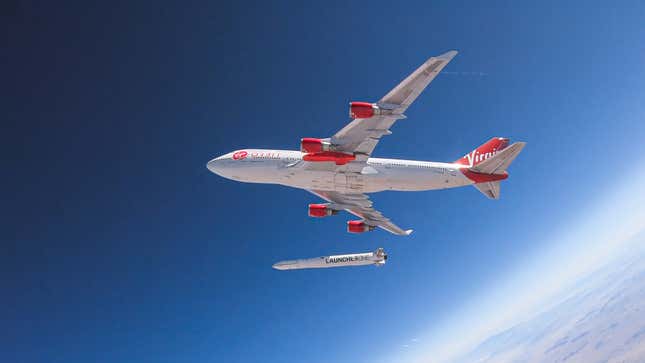
The commercial race to space just got a little more crowded. Richard Branson’s Virgin Orbit, Virgin Galactic’s sister company, has successfully launched a rocket into orbit for the first time. It also managed to successfully deliver payloads for a customer, NASA, dropping off a number of nanosatellites sponsored by the agency.
On Sunday, Virgin Orbit carried out its second test flight of its LauncherOne rocket, which is launched into space using an unconventional launch system. Instead of lifting off from a launch pad on the ground, the rocket is carried under the wing of a customized Boeing 747, named “Cosmic Girl,” and released at a predetermined location. Once it’s released, the rocket ignites and powers itself to orbit. That’s exactly what happened on Sunday.
As explained by the Verge, by launching its rocket from a plane in the air, Virgin Orbit’s launch system doesn’t need as big a rocket or as much fuel. This is good from a financial perspective, as it helps keeps cost down. In addition, the outlet notes that the company maintains that its system is potentially more flexible than others, as it could in theory launch satellites from any place that a 737 can take off and land.
“Virgin Orbit has achieved something many thought impossible,” Branson said in a statement on Sunday. “It was so inspiring to see our specially adapted Virgin Atlantic 747, Cosmic Girl, send the LauncherOne rocket soaring into orbit. This magnificent flight is the culmination of many years of hard work and will also unleash a whole new generation of innovators on the path to orbit.”
The successful launch was a redemption for Virgin Orbit, which did not manage to reach orbit on its first test flight in May of last year. The company later said a problem with a propellant line, which broke seconds after the rocket’s engine ignited, was behind the failure.
Unlike Virgin Galactic, which has its eye set on space tourism, Virgin Orbit is all about launching small satellites.
LauncherOne carried 10 nanosatellites, called CubeSats, that are part of NASA’s Educational Launch of Nanonsatellites initiative. The program is designed to attract and retain students in STEM, per NASA, and students are involved in all aspects of the mission, from development and assembly to testing and launching.
They’re called nanosatellites for a reason. CubeSats are designed to be 10x10x10 cm, or about four inches cubed, the agency explains. Although they can be composed of single units, which must weigh less than three pounds (1.33 kilograms), they can also be combined to form two, three, or six units. The CubeSats that were carried by LauncherOne were created by eight U.S. universities as well as NASA itself. The satellites will work to research topics such as space weather, space radiation, and space debris, among others.
Virgin Orbit stated that it already had a number of customers booked for subsequent launches, including the U.S. Space Force, the United Kingdom’s Royal Force, Italian private space company SITAEL, and Danish satellite manufacturer GomSpace, among others.